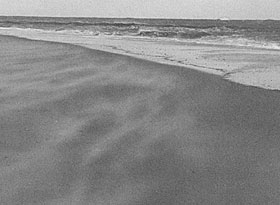Sand Dunes
How do sand dunes form?
Types of Sand Dunes
Artificial Sand Dunes
Common Dune Forms
Blowouts
Cross Bedding
Dune Grasses and Dunes
Problems With Bulldozed and Artificial Dunes
How do sand dunes form?
Although no more than a pile of wind-blown sand, dunes take on a remarkable range of sizes and shapes, depending on the amount of sand available, the size of the sand, and the prevailing wind directions. Over time dunes can grow, shrink, or move in the direction of prevailing winds. Dunes can be created and destroyed by either nature or humans. Dunes can roll over trees and buildings, or be washed away by storms.
The beach is the sole source of sand for coastal dunes, and every single sand grain in a dune has come across the beach at some time in its history. In fact, each grain probably has made the trip many times (Fig. 3.1) because when the wind reverses and blows offshore some of the grains go right back to the beach. Certainly the prominent scarp (see Fig. 1.10), often seen in the toe of the dune after a storm, is evidence that waves have redistributed dune sand back to the beach. Sand can come ashore from both the sound beach and the ocean-side beach.
Dune building is helped along by the characteristic onshore coastal winds. Regardless of the general wind circulation patterns of the region, winds will blow onshore at least some of the time, and if there is vegetation, some of the sand will be trapped to grow a dune. Not only is the sand moving, but also the energy is sometimes transferred to other objects. A glass bottle left on the beach will become frosted. As the sand grains sandblast the shine and clarity of the glass surface.
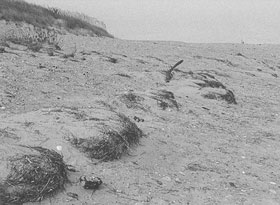
Figure 3.2. Spartina (salt marsh) straw on the beach on Ocracoke Island. The wrack line of straw caused sand to accumulate and now will furnish nutrients to any plants that are seeded here.
Dunes commonly begin as piles of sand accumulated in the lee of beach debris such as piles of seaweed (especially Sargassum), clumps of salt marsh straw, and a host of human refuse (fishing nets, bottles, timbers) (Figs. 3.2 and 3.3). Beach debris slows down the wind or blocks it, causing sand to accumulate in the wind “shadow” of the object. Eventually, dune grass seeds (especially Sea Oats) find their way to the new piles of sand, germinate, sprout and trap more sand. The rotting vegetation, seaweed or salt marsh grass that caused the sand accumulation to begin with now furnishes nutrients to help the new seedlings survive. As the plant grows it continues to cause more and more sand to accumulate. If all goes well and the surf zone stays far enough away, a new dune is born! As these embryonic dune grow, the vegetation keeps moving up and out, holding much of the sand in place.
Types of Sand Dunes
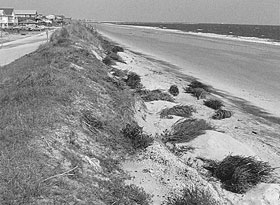
Figure 3.3. Christmas trees piled in front of the dune at Holden Beach in March 2002. Actions like this are taken in hopes that the trees will trap sand and build up the dune, but in general, this approach has not worked, and the beach merely becomes cluttered with dead trees.
Commonly, the dune at the back of a natural beach is called the foredune, a ridge of sand forming with its axis, or crest, parallel to the shoreline. Such a dune or sand ridge in association with a beach also is called a beach ridge. The vegetation serves as an anchor for wind-blown sediment and generates continuous dune growth. When the grass is removed by storms, fire, trampling, overgrazing, or simply too much sand coming ashore across the beach, the dunes are destabilized and may begin to migrate landward.
Medaños is the term used to describe isolated large dunes found in coastal areas. Medaños derive their name from the Spanish word for “coastal sand hill,” and are a distinctive type of unvegetated dune. These high, steep, isolated sand hills have tremendous volumes of sand and range in height anywhere from tens to several hundreds of feet. Medaños are formed by winds moving sand upward toward the summit from several directions. Despite their lack of vegetation, medaños migrate only slowly perhaps because of the number of different wind directions that transport wind to the dunes.
These dunes are not well understood and may simply represent piles of sand where there is an exceptionally high amount of sand coming to the beach. But why should the large amount of sand come ashore from the shoreface at a particular spot? The answer to the origin of the Outer Banks Medanos must lie on the continental shelf, the ultimate source of the sand. Artificial dunes were added to the list of dune types in the 20th Century when people began to build dunes in an attempt to hold the shoreline in place. Attempts to improve existing dunes or to create new dunes usually include planting dune grasses and/or using “sand fences.” The fences reduce wind velocities and cause sand to drop and accumulate in their shadow. They work with varying success. One study in New Jersey indicated that the most important role of the sand fences was to keep people off the new dunes allowing dune plants to prosper.
Artificial Sand Dunes
Bulldozing has become a common form of artificial dune construction, in part because the vegetation/fencing approach takes some time to trap sand and build a new dune. On many beaches, bulldozers are active throughout the year in pushing up sand piles at the back of the beach. We can hardly call these sand-dike features dunes because they lack all of the characteristics of natural dunes (e.g., well-sorted and stratified sands that support the growth of stabilizing dune grasses). The granddaddy of artificial dunes was the old Civilian Conservation Corps (CCC) dune building project on the Outer Banks of North Carolina, USA in the 1930s. That old dune line is often breached in storms and new large artificial dunes plug holes in the line. Once upon a time, even old cars were used to help stabilize dunes there!
The motivation behind artificial dune stabilization has been to hold an eroding shoreline in place. Ironically, new dune construction probably has little bearing on rates of erosion. The volume of sand in dunes is very small compared to the volume of sand involved in erosion. The retreat of the shoreline is actually a retreat of the entire shoreface, which constitutes a large volume of sand, many times larger than the volumes of foredunes. Thus, in the process of erosion, dunes can be swept away and do little the hold the shoreline in place.
Common Dune Forms

Figure 3.4. An overwash pass between low natural dunes on Ocracoke. Sea oats encourage the formation of individual dunes (rather than a continuous line of dunes) seperated by passes or low areas that allow overwash into the interior of the island. This penetration of sediment is important, as it helps the island raise its elevation in response to sea-level rise.
The size of a dune is mainly a function of sand supply: the larger the supply from the beach, the higher the dunes. Prevailing wind directions, beach width and time available to build a dune are part of the sand supply picture. Most important however is the sand available from the sea. So far it is not clear why more sand comes ashore in some locations and builds big dunes while 100 yards away dunes are small and low. Most foredunes have occasional gaps between them where the storm waves penetrate into the islands. These openings are referred to as overwash passes (see Fig. 3.4) and they are very important for the islands evolution especially in a time of rising sea level. Overwash passes allow accumulation of storm – derived sand which elevates the islands (discussed below). Some overwash passes are the result of artificial cuts through dunes at the ends of roads and streets. Even those that appear to be natural are often the result of waves breaching a weak zone (Fig. 3.6) induced by human activities (e.g., footpaths, backside notching for construction or a better view of the sea). When the foredune is very large there are no overwash gaps. Overwash deposits on the back sides of dunes are easily distinguishable from dune sands because of their high shell content. Waves can bring seashells ashore, but winds can’t.
Blowouts
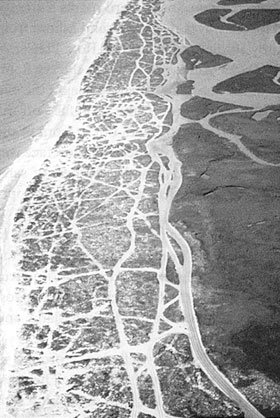
Figure 3.6. Beach buggy trails through the dunes south of Fort Fisher. Clearly, unrestricted vehicular traffic is damaging to dune vegetation.
One way in which sand dunes are eroded is by the wind remobilizing sand and blowing it out of the dune, a process known as deflation. The most common deflation feature is the blowout, a bowl-shaped depression with a flat floor that lies below the elevation of most of the adjacent dunes. Blowouts are flat-floored because the sand is blown away until the sand surface reaches the top of the water table. At this level, the wet sand resists being blown away and the surface becomes vegetated. You can test this water table control of wind processes by digging a hole with your hands in a North Carolina blowout. Less than a forearm’s length below the surface, you will reach freshwater.
Cross Bedding
The faster the wind, the bigger the sand sizes that can be picked up and moved. Since the speed and direction of the wind changes all the time, the appearance of a dune surface varies in texture, color, grain size, and bedforms almost on a daily basis. In the dune, consecutive layers of windblown sand build on top of each other and, over time, the layers form a unique type of layering or stratification called wind cross-bedding. Cross-beds, which can usually be seen in erosional scarps next to the beach have several sets of sand layers that are inclined at different angles (Fig. 3.7). Each single layer indicates a former surface of the dune.
Dune stratification is usually made up of hundreds of very thin alternating layers of quartz sand, shell fragment sand and heavy mineral sand plus some layers that are mixtures of all three. The black layers, some only a grain or two thick are the heavy mineral strata. Shell fragment layers are usually brown colored. These layers were each deposited under differing wind conditions. Perhaps single gusts of wind can form some layers while others may reflect wind conditions over minutes to hours. The winnowing of light grains leaving behind a dark layer of heavy minerals forms some layers. The surface of the dune that you are walking on will someday be a layer exposed in an erosion scarp at the beach! Perhaps even you footprints will remain.
Dune Grasses and Dunes
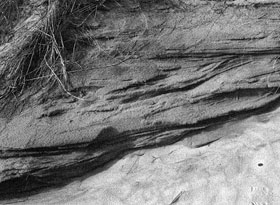
Figure 3.7. Cross-bedding in a dune in Kill Devil Hills. Two distinct orientations of bedding are apparent, with the upper, almost flat layering sharply truncating the lower strata. Each of the layers visisble here was once at the surface of the dune.
Dune grass stabilizes the sand in which it is growing and the way the grass spreads will inevitably affect the shape of the dune. Due to the clustering nature of the some grasses, dunes that are dominated by grass may have gaps or overwash passes. Such gaps facilitate the penetration of storm waves onto the island. In contrast, dunes dominated by other grass types may have fewer gaps. This prevents or reduces storm overwash except in the larger storms. Penetration of the storm waves through the dunes is important because it brings overwash sand to the island, raising its elevation. Vertical growth through the accumulated overwash and dune sand is important for a barrier island to evolve with a rising sea level.
Once grasses stabilize the dune line, additional plants take hold, particularly on the more protected landward side of the dune. Plants on islands and near beaches need varying degrees of protection from wind and salt spray. If multiple dune ridges form, the swales in between will be populated by shrubs, vines, small trees, and ultimately in the succession of plants, a maritime forest may grow. Under natural conditions, the types and density of vegetation are indicators of the age and length of stability of dunes. Grasses may be established within a season, but shrubs take 10 to 20 years to become established, and decades, even centuries, are required to grow a maritime forest. When mature forest is removed for development, the vegetative equilibrium is disrupted. Overgrazing by cattle and horses, a widespread problem in some areas, removes certain plant species, damages salt marshes and prevents much under-canopy growth in maritime forests.
Problems With Bulldozed and Artificial Dunes
On many beaches, it is legal with the correct permits in hand to bulldoze beaches to form “dunes” or at least to form piles of sand up against buildings for storm protection. Bulldozed “dunes” are easy to spot. These “dunes” have a different shape than natural dunes, and often look like large piles of sand that have been dumped on the beach. These piles of sand contain a lot of shell material, a rare component of natural dune sand. After a few days on the upper beach, wind will blow away the finer sand on the surface, causing a layer of shells or “shell lag” to form on the surface of a bulldozed dune. Because wind often can’t blow shells into dunes, the shell lag is a positive indicator that the bulldozer has paid a visit. Natural dunes, especially those with roots entangled throughout the sand, provide a solid (if temporary) bulwark against a minor storm. When attacked by waves, a scarp or small bluff quickly forms. Subsequent waves are at least partly reflected from the scarp, rolling back down the beach and smashing into the next wave coming ashore. Bit by bit, however, the dune scarp moves landward under wave attack. Helping to reinforce and strengthen natural dunes (in addition to the beneficial effect of plant roots) are electronic forces, or Vanderwaal forces, between the uniform sized sand grains and the water between the grains. In bulldozed “dunes”, which are made up of beach sand with a wide size range of quartz grains and shell fragments, neither roots nor Vanderwaal forces are at work to stabilize the deposit. As a consequence the artificial dunes erode with much greater ease. The bulldozed sand, minus the animals that once lived there, returns to the beach (usually during the next storm) and the dunes are flattened and washed inland.
Beach bulldozing, or beach scraping, removes a thin layer of sand from the inner swash zone (usually a foot or less in thickness) in an attempt to encourage additional sand accumulation. Often, however, the legal limit of one-foot penetration into the beach is violated. The scraped sand is pushed to the back of the beach, usually into a low sand ridge. Bulldozing sand is not a good thing for beaches. For one, taking sand from any part of the beach is a form of beach erosion, pure and simple. For another, it kills the organisms in the beach—the mole crabs, the coquina clams, and all the microscopic organisms that live between the sand grains. For days after bulldozing, seagulls have an unexpected bonanza; swooping and grabbing the stranded and struggling critters of the beach that are now high and dry in the bulldozed dune. The odor of rotting organisms during the post-bulldozing time also can provide an unpleasant atmosphere for beach strollers. The process affects the whole food chain including the shorebirds and the nearshore fish.

